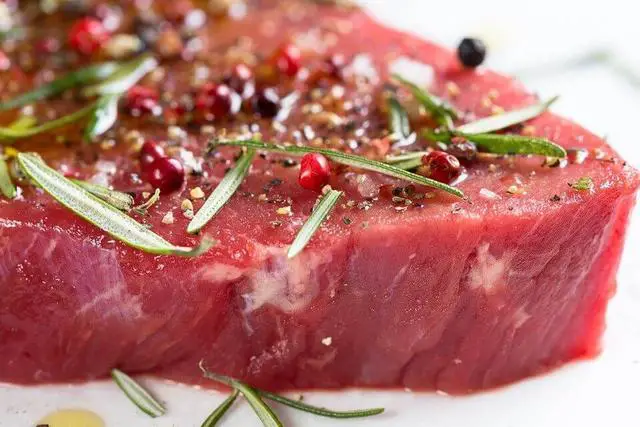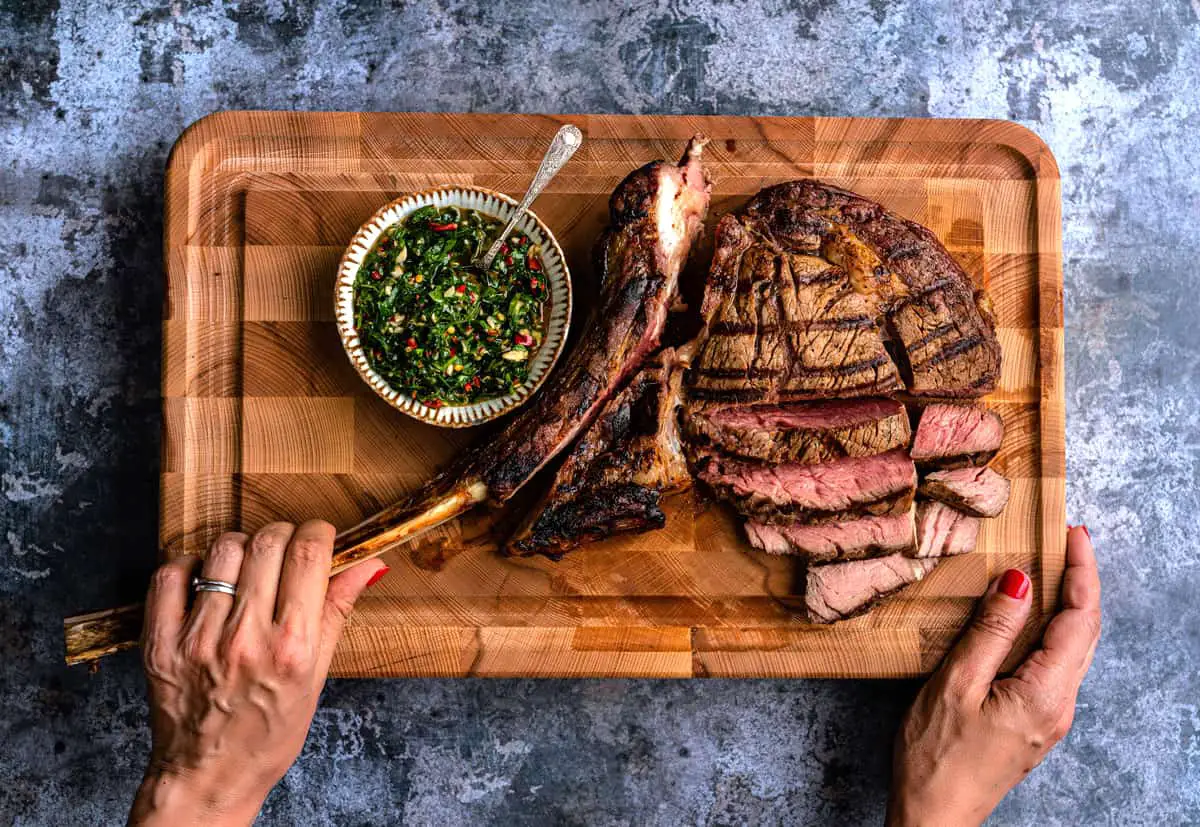
Pepperoni, a beloved pizza topping, is a deliciously spicy and flavorful cured meat. But have you ever wondered what exactly goes into making this iconic ingredient? Join us as we dive into the world of pepperoni and uncover the secret behind its irresistible taste. From its origins to the unique blend of meats and spices used in its preparation, get ready to discover what makes pepperoni truly one-of-a-kind.
1. The Ingredients and Process Behind Making Pepperoni
Pepperoni is a popular sausage topping that is used not only on pizzas but also in various other dishes like pizza rolls and Italian hoagies. It is made from a mixture of ground pork and beef, combined with spices and flavorings. To preserve the meat, salt and sodium nitrate are added, which prevent the growth of unwanted microorganisms. The addition of lactic acid bacteria helps lower the meat’s pH balance, allowing it to be better preserved for later consumption.

After the meat mixture is prepared, it is stuffed into casings and left to ferment for several days. This fermentation process gives pepperoni its distinct flavor. Following fermentation, the pepperoni is moved to a drying room where it can stay for up to 20 days. During this time, it fully dries out and develops its characteristic color. Once dried, the pepperoni is packaged and shipped.
In the United States, most pepperoni is made from pork. However, there are mixed varieties available that consist of both pork and beef being ground and encased together. At Tuscan Pizza, they pride themselves on using high-quality ingredients sourced from local suppliers.
Sliced Pepperoni Ingredients:
– Ground pork and beef
– Spices
– Flavorings
– Acids that aid in the preservation process
Pepperoni is a beloved topping at Tuscan Pizza and can be enjoyed in various dishes such as specialty pies like Works and Meat Lovers, strombolis, calzones, and pizza rolls. While it may be a popular choice in the United States, traditional Italian pizzas typically omit pepperoni as one of their toppings.
Overall, making pepperoni involves a careful process of combining meats with spices and flavorings before curing them with salt and sodium nitrate. The fermentation and drying stages further enhance its taste and texture, resulting in the delicious cured meat that is enjoyed on pizzas and other dishes.
2. Uncovering the Origins of Pepperoni: A Closer Look at Its Creation
Pepperoni, a beloved pizza topping and ingredient in various Italian dishes, has an interesting history that may surprise many. Contrary to popular belief, pepperoni is not actually an Italian invention. According to food writer and historian John Mariana, pepperoni is purely an Italian-American creation, much like Chicken Parmesan. Mariana noted that there is no traditional Italian salami called pepperoni. Instead, it is believed to be an American innovation.
The first recorded use of the term “pepperoni” dates back to 1919 in the United States. This coincided with the rise of pizzerias and Italian butcher shops on the East Coast. While some spicy salamis in Italy, particularly those found in Milan, have a similar flavor and color profile to pepperoni, they are not referred to as such.
So how exactly is pepperoni made? It starts with a mixture of ground pork and beef blended with spices and flavorings. To ensure preservation and prevent the growth of unwanted microorganisms, salt and sodium nitrate are added. The addition of nitrate also gives pepperoni its characteristic reddish color.

To further preserve the meat, lactic acid bacteria are injected into the ground meat mixture to lower its pH balance. This step allows for better preservation over time. The mixture is then stuffed into casings and left to ferment for several days before being transferred to a drying room where it can stay for up to 20 days.
Once fully dried, pepperoni is packaged and shipped to various establishments. Depending on the manufacturer’s preference, some pepperonis are sliced while others remain whole. In the United States, pork is typically used as the main ingredient for making pepperoni. However, there are also mixed varieties that include both pork and beef.
At Tuscan Pizza, we take pride in using high-quality ingredients, including sliced pepperoni. Our local supplier ensures that our pepperoni contains acids that aid in the preservation process, allowing you to enjoy this delicious cured meat on our specialty pies such as the Works and Meat Lovers. Additionally, we offer pepperoni in strombolis, calzones, and pizza rolls for those who can’t get enough of this popular topping.
Interestingly, while pepperoni is a staple topping in the United States, it is not as commonly found on pizzas in Italy. Traditional Italian pizzas typically omit pepperoni altogether. With seven types of traditional Italian pizza to choose from, pepperoni lovers may find themselves indulging more when dining at American pizzerias like ours.
In conclusion, the origins of pepperoni reveal an intriguing history. Despite its association with Italian cuisine, it was actually created in America and has become a favorite topping for many pizza enthusiasts. Whether you enjoy it on a classic pizza or in other dishes like strombolis and calzones, there are plenty of ways to savor the deliciousness of pepperoni at Tuscan Pizza.
3. From Ground Meat to Dried Delicacy: How Pepperoni is Made

Pepperoni, a popular and versatile ingredient, is not only limited to pizza but also used in pizza rolls and Italian hoagies. Despite its association with Italian cuisine, pepperoni was actually invented in the United States. In John Mariana’s book “How Italian Food Conquered the World,” it is noted that pepperoni is purely an Italian-American creation, similar to Chicken Parmesan. There is no traditional Italian salami called pepperoni, although there are spicy salamis in Italy with a similar flavor and color. The first use of the word “pepperoni” in print appeared in the United States in 1919 when pizzerias and Italian butcher shops began emerging on the East Coast.
To make pepperoni, a mixture of ground pork and beef is combined with spices and flavorings. Salt and sodium nitrate are added to cure the meat and prevent the growth of unwanted microorganisms. The addition of nitrate gives pepperoni its characteristic color. Lactic acid bacteria are injected into the ground meat to lower its pH balance, enhancing preservation. The mixture is then stuffed into casings and ferments for several days before being moved to a drying room where it can stay for up to 20 days. Once fully dried, the pepperoni is packaged and shipped, with some manufacturers slicing it while others keep it whole.
In the United States, pepperoni is typically made from pork. However, there are mixed varieties that include both pork and beef being ground together. At Tuscan Pizza, they pride themselves on using high-quality ingredients in their sliced pepperoni, which includes acids that aid in the preservation process.
While pepperoni is a popular topping in the United States, it is not as commonly found on traditional Italian pizzas. Traditional Italian pizzas omit pepperoni as there are seven types of traditional Italian pizza that primarily focus on other toppings. However, at Tuscan Pizza, there are plenty of ways to enjoy pepperoni, including on specialty pies like the Works and Meat Lovers, as well as in strombolis, calzones, and pizza rolls.
Overall, pepperoni undergoes a process from ground meat to dried delicacy. It is made by combining ground pork and beef with spices and flavorings, curing the meat with salt and sodium nitrate, injecting lactic acid bacteria for preservation, fermenting the mixture in casings for several days, drying it in a dedicated room for up to 20 days, and finally packaging and shipping it.
4. Exploring the Flavorful Components of Pepperoni Sausage
Pepperoni sausage is a beloved ingredient in various dishes, especially pizza. But have you ever wondered what gives it its unique and delicious flavor? Let’s dive into the flavorful components that make pepperoni so irresistible.
One key ingredient in pepperoni is a mixture of ground pork and beef. These meats are combined with spices and flavorings to create the distinct taste that we associate with pepperoni. The combination of pork and beef adds depth to the flavor profile, making it savory and satisfying.
To preserve the meat and prevent the growth of unwanted microorganisms, salt and sodium nitrate are added to the mixture. Nitrate also plays a role in giving pepperoni its characteristic color. After nitrate is added, lactic acid bacteria are injected into the ground meat to lower its pH balance. This step helps in preserving the meat for later consumption.
Once the ground meat mixture is prepared, it is stuffed into casings and left to ferment for several days. This fermentation process enhances the flavors of the pepperoni, making it even more delicious. After fermentation, the pepperoni is moved to a drying room where it can stay for up to 20 days. This drying process further intensifies the flavors and allows for better preservation.
Depending on the manufacturer, some pepperoni is sliced while others remain whole. In the United States, pepperoni is typically made from pork. However, mixed varieties that consist of both pork and beef are also available.
At Tuscan Pizza, we take pride in using high-quality ingredients for our sliced pepperoni toppings. Our local supplier ensures that our sliced pepperoni includes acids that aid in the preservation process, maintaining its freshness and flavor.
If you’re a fan of pepperoni like us, there are plenty of ways to enjoy this flavorful sausage at Tuscan Pizza. You can find it as a topping on our Works and Meat Lovers specialty pizzas. Additionally, we offer pepperoni in strombolis, calzones, and pizza rolls. While pepperoni may not be as popular in traditional Italian pizza, it remains a beloved choice for many pizza lovers in the United States.
So next time you indulge in a slice of pepperoni pizza or bite into a delicious calzone, take a moment to appreciate the complex flavors that make pepperoni sausage so irresistible.
5. The Science Behind Preserving Pepperoni: A Dive into the Curing Process

Pepperoni, a popular pizza topping and ingredient in various Italian dishes, goes through a specific curing process to ensure its preservation and flavor. The process begins with a mixture of ground pork and beef, which is combined with spices and flavorings. To prevent the growth of unwanted microorganisms, salt and sodium nitrate are added to cure the meat.
One important step in the curing process is injecting lactic acid bacteria into the ground meat. This helps lower the meat’s pH balance, allowing it to be better preserved for later consumption. After this step, the ground meat mixture is stuffed into casings and left to ferment for several days.
Following fermentation, pepperoni is moved to a drying room where it can stay for up to 20 days. During this time, the pepperoni develops its characteristic color. Once fully dried, it is packaged and shipped. Some manufacturers slice the pepperoni before packaging, while others keep it whole.
In the United States, pepperoni is typically made from pork. However, there are mixed varieties that consist of both pork and beef being ground and encased together.
At Tuscan Pizza, we take pride in using high-quality ingredients for our sliced pepperoni. Our local supplier ensures that our sliced pepperoni contains acids that aid in the preservation process.
If you’re a fan of pepperoni like us, there are plenty of ways to enjoy this cured meat at Tuscan Pizza. It can be found as a topping on our Works and Meat Lovers specialty pies. Additionally, you can find it in strombolis, calzones, and pizza rolls! While pepperoni may not be as popular in Italy as it is in the US (where it consistently ranks as one of the best pizza toppings), we embrace its deliciousness here at Tuscan Pizza.
Overall, the science behind preserving pepperoni involves a careful curing process that includes adding spices and flavorings, curing with salt and sodium nitrate, injecting lactic acid bacteria to lower the meat’s pH balance, fermenting the mixture in casings, and drying it for several days. This process ensures the preservation and unique flavors of this beloved pizza topping.
6. Pork, Beef, and Spices: Understanding the Composition of Pepperoni

Pepperoni is a popular cured meat that is commonly used as a topping on pizzas, in pizza rolls, and Italian hoagies. It is made from a mixture of ground pork and beef, which is then mixed with spices and flavorings. The meat is cured using salt and sodium nitrate to prevent the growth of unwanted microorganisms.
The distinctive color of pepperoni comes from the addition of nitrate. Lactic acid bacteria are injected into the ground meat mixture to lower its pH balance, allowing it to be better preserved for later consumption. The mixture is then stuffed into casings and left to ferment for several days.
After fermentation, the pepperoni is moved to a drying room where it can stay for up to 20 days. This drying process helps enhance the flavor and texture of the meat. Once fully dried, the pepperoni is packaged and shipped. Some manufacturers slice the pepperoni before packaging, while others leave it whole.
In the United States, pepperoni is typically made solely from pork. However, there are mixed varieties available that consist of both pork and beef being ground and encased together.
At Tuscan Pizza, we take pride in using high-quality ingredients for our sliced pepperoni toppings. Our local supplier ensures that our sliced pepperoni contains acids that aid in the preservation process.
If you love pepperoni like we do at Tuscan Pizza, you can enjoy it in various dishes such as our Works and Meat Lovers specialty pies, strombolis, calzones, and pizza rolls! While pepperoni is a popular topping in the US, it’s not as commonly found on traditional Italian pizzas.
Overall, understanding the composition of pepperoni gives us insight into how this delicious cured meat is made and why it has become such a beloved ingredient in many dishes.
7. Tuscan Pizza’s Sliced Pepperoni: What Goes into This Popular Topping?
Pepperoni, a spicy sausage that is consistently named the best pizza topping year after year, is not limited to just pizza. At Tuscan Pizza, we use pepperoni as one of the primary ingredients for our popular pizza rolls and Italian hoagies. We have tried this flavorful sausage on nearly everything because there are so many ways to enjoy it.
Interestingly, despite its association with Italian cuisine, pepperoni was not actually invented in Italy. According to food writer and historian John Mariana, pepperoni is purely an Italian-American creation, similar to Chicken Parmesan. Mariana claimed that there is no Italian salami called pepperoni and it is believed to be an American invention. The first use of the word “pepperoni” in print does not show up until 1919 in the United States.
So how is pepperoni made? It starts with a mixture of ground pork and beef mixed with spices and flavorings. Salt and sodium nitrate are then added to cure the meat and prevent the growth of unwanted microorganisms. The ground meat mixture is injected with lactic acid bacteria to lower its pH balance, which helps preserve it for later consumption. After fermenting for several days, the mixture is stuffed into casings and moved to a drying room where it can stay for up to 20 days. Once fully dried, the pepperoni is packaged and shipped.
In the United States, pepperoni is typically made of pork. However, there are also mixed varieties that consist of both pork and beef being ground and encased together.
At Tuscan Pizza, we pride ourselves on using high-quality ingredients for our sliced pepperoni. Our local supplier provides us with sliced pepperoni that includes acids that aid in the preservation process.
If you love pepperoni like we do, you can enjoy it in various ways at Tuscan Pizza. It is a popular topping on our Works and Meat Lovers specialty pies, as well as in strombolis, calzones, and pizza rolls. While pepperoni may not be as popular in Italy, it is certainly a favorite here in the United States.
So next time you visit Tuscan Pizza, be sure to try our delicious sliced pepperoni and experience the flavor that has made it consistently named the best pizza topping year after year.
8. America’s Love Affair with Pepperoni: Why It’s a Staple on Pizzas and More
Pepperoni has become a beloved pizza topping in America, consistently named the best year after year. However, its popularity extends beyond just pizza. At Tuscan Pizza, we use pepperoni as one of the primary ingredients in our popular pizza rolls and Italian hoagies. We have even experimented with adding this spicy sausage to various dishes because there are so many ways to enjoy it.
Interestingly, despite its association with Italian cuisine, pepperoni is not actually an Italian invention. In John Mariana’s book “How Italian Food Conquered the World,” he noted that pepperoni is purely an Italian-American creation, similar to Chicken Parmesan. There is no traditional Italian salami called pepperoni. While some spicy salamis in Italy have a similar flavor and color, the first mention of pepperoni in print was in 1919 in the United States.
The process of making pepperoni involves mixing ground pork and beef with spices and flavorings. Salt and sodium nitrate are added to cure the meat and prevent the growth of unwanted microorganisms. The addition of lactic acid bacteria lowers the meat’s pH balance, allowing for better preservation. The ground meat mixture is then stuffed into casings and ferments for several days before being moved to a drying room where it can stay for up to 20 days. Once fully dried, the pepperoni is packaged and shipped.
In the United States, pork is typically used to make pepperoni. However, there are mixed varieties that consist of both pork and beef being ground and encased together.
At Tuscan Pizza, we take pride in using high-quality ingredients for our sliced pepperoni toppings. Our local supplier ensures that our sliced pepperoni contains acids that aid in the preservation process.
While pepperoni is a popular topping in the United States, it is not as widely used in traditional Italian pizza. In Italy, there are seven types of traditional pizza, and pepperoni is primarily omitted from these varieties.
If you’re a fan of pepperoni, there are plenty of ways to enjoy this cured meat at Tuscan Pizza. It is featured on our Works and Meat Lovers specialty pies, as well as in strombolis, calzones, and pizza rolls.
Summary:
Pepperoni has become a staple topping on pizzas in America. Despite being associated with Italian cuisine, it is actually an Italian-American creation. The process of making pepperoni involves mixing ground pork and beef with spices and flavorings, curing the meat with salt and sodium nitrate, and fermenting it for several days before drying. In the United States, pepperoni is typically made of pork but can also include beef. At Tuscan Pizza, we use high-quality ingredients for our sliced pepperoni toppings. While popular in the US, traditional Italian pizza varieties do not typically include pepperoni.
9. The Italian-American Connection: Tracing the Evolution of Pepperoni

Pepperoni, a beloved and popular pizza topping, has deep roots in Italian-American cuisine. Contrary to popular belief, pepperoni is not an authentic Italian creation but rather an Italian-American invention. Food writer and historian John Mariana noted in his book that there is no traditional Italian salami called pepperoni. Instead, it is a product of the fusion between Italian and American culinary traditions.
The first recorded use of the word “pepperoni” in print appeared in 1919 in the United States. This coincided with the rise of pizzerias and Italian butcher shops on the East Coast. While there are spicy salamis in Italy that resemble pepperoni in flavor and color, they are not referred to as such.
The process of making pepperoni involves a mixture of ground pork and beef combined with spices and flavorings. Salt and sodium nitrate are added to cure the meat and prevent the growth of unwanted microorganisms. The addition of lactic acid bacteria lowers the meat’s pH balance, aiding in its preservation. The ground meat mixture is then stuffed into casings and undergoes fermentation for several days before being moved to a drying room for up to 20 days.
In the United States, pepperoni is typically made solely from pork. However, there are mixed varieties available that include both pork and beef. At Tuscan Pizza, we take pride in using high-quality ingredients for our sliced pepperoni toppings.
While pepperoni is widely loved in the United States and commonly used as a pizza topping, it is not as popular in Italy. Traditional Italian pizzas often omit pepperoni altogether, focusing on other classic toppings such as margherita or prosciutto.
At Tuscan Pizza, we offer various ways to enjoy this flavorful cured meat beyond just pizza. Our Works and Meat Lovers specialty pies feature pepperoni as a key ingredient. Additionally, you can find pepperoni in our strombolis, calzones, and pizza rolls. So whether you’re a fan of traditional Italian flavors or the American twist on them, there’s something for everyone to enjoy at Tuscan Pizza.
(Source: Tuscan Pizza website)
10. From Pizza Rolls to Hoagies: Discovering the Versatility of Pepperoni

Pepperoni, consistently named the best pizza topping year after year, is not limited to just pizza. At Tuscan Pizza, we use pepperoni as one of our primary ingredients for our popular pizza rolls and Italian hoagies. We have discovered so many delicious ways to enjoy this spicy sausage that we’ve tried it on nearly everything.
Interestingly, the word “pepperoni” comes from the Italian word “peperoni,” which is the plural form of “peperone,” meaning bell pepper. Despite being associated with Italian cuisine, pepperoni was actually invented in America. According to food writer and historian John Mariana, there is no Italian salami called pepperoni. It is believed to be an Italian-American creation, similar to Chicken Parmesan.
The first recorded use of pepperoni in print dates back to 1919 in the United States. Around this time, pizzerias and Italian butcher shops began popping up on the East Coast. Pepperoni is made from a mixture of ground pork and beef mixed with spices and flavorings. Salt and sodium nitrate are added to cure the meat and prevent the growth of unwanted microorganisms.
To achieve its signature color, lactic acid bacteria are injected into the ground meat mixture to lower its pH balance. This process allows it to become better preserved for later consumption. The mixture is then stuffed into casings and ferments for several days before being moved to a drying room where it can stay for up to 20 days.
Depending on the manufacturer, some pepperoni is sliced while others remain whole. In the United States, it is typically made of pork, but there are also mixed varieties that consist of pork and beef being ground and encased together.
At Tuscan Pizza, we take pride in using only the best ingredients for our sliced pepperoni. Our local supplier provides us with a high-quality product that includes acids to aid in the preservation process.
If you love pepperoni, there are plenty of ways to enjoy this delicious cured meat at Tuscan Pizza. It is featured as a topping on our Works and Meat Lovers specialty pies. You can also find it in strombolis, calzones, and pizza rolls! While pepperoni is a popular topping in the United States, it is not as commonly found on traditional Italian pizzas.
Pepperoni’s versatility and bold flavor make it a beloved choice among pizza lovers. Whether you prefer it on top of a pizza or stuffed inside a hoagie, pepperoni adds a delicious kick to any dish. So next time you’re craving something savory and spicy, give our pepperoni creations a try at Tuscan Pizza!
In conclusion, pepperoni is a popular type of sausage that is typically made from a combination of pork and beef, seasoned with various spices and cured for flavor. Its distinct taste and versatility make it a beloved topping for pizzas and a flavorful addition to many dishes.
Learn More About Grilling
If you want to learn more about grilling, check out these other helpful resources!











